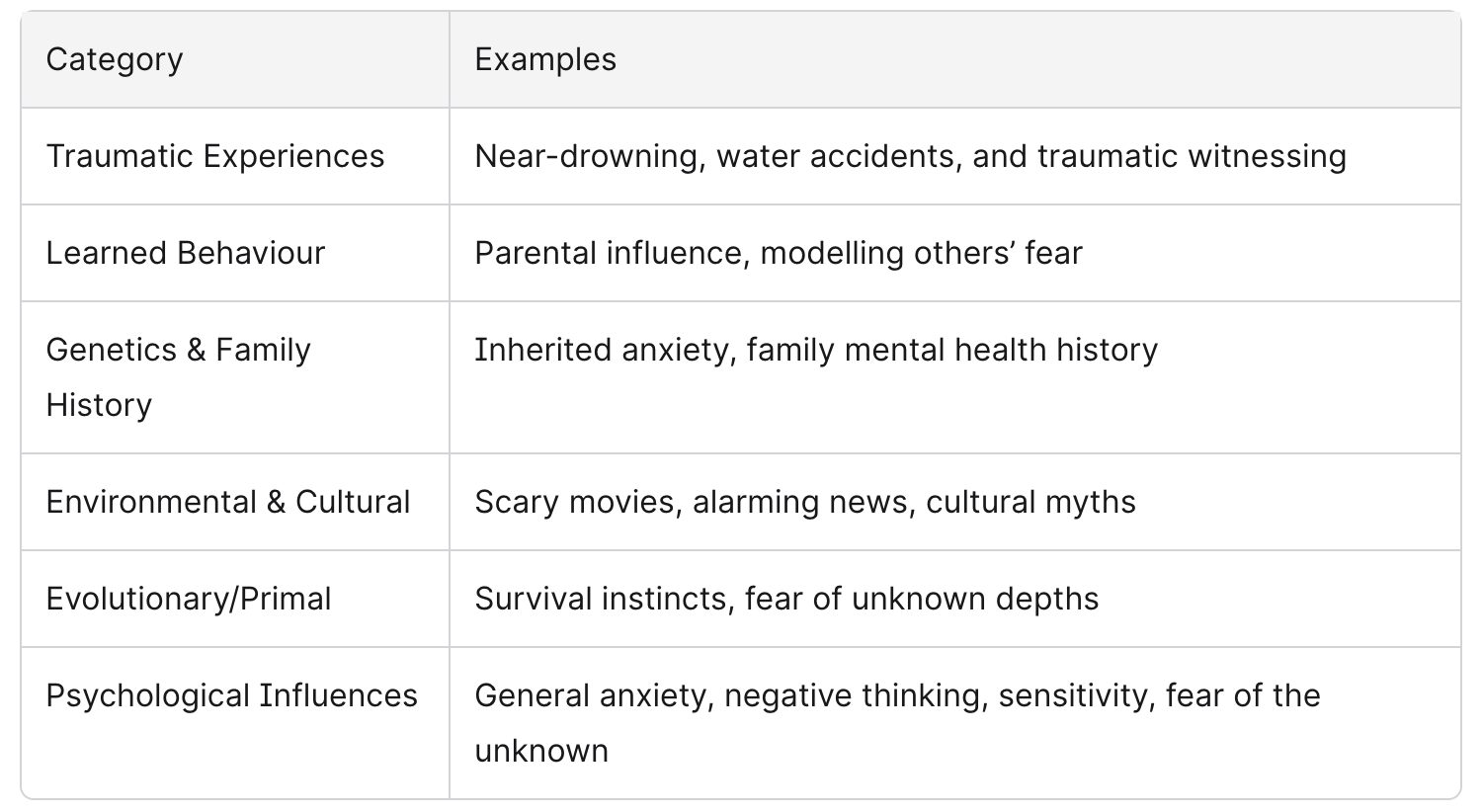What is Thalassophobia? Understanding the Intense Fear of Deep Water
Are your palms sweaty at the thought of wading into the deep sea, or does the mere image of the dark ocean make your heart race? If so, you’re not alone.
In this article, we’ll dive deep into what is thalassophobia, explore its roots, symptoms, and treatment, and offer practical tips (with a splash of wit) to help you find calm amidst the tide of fear.
What is Thalassophobia?
Thalassophobia is a specific anxiety disorder characterised by an intense fear of large, deep, or open bodies of water, like the ocean, deep lakes, or the vast sea.
This persistent fear, often disproportionate to any actual danger, can send even the bravest souls into a wave of significant distress. For some, the thought of the deep ocean triggers anxiety symptoms; for others, encountering the sea itself can lead to panic attacks or obsessive avoidance behaviours.
The Origins of Thalassophobia
If you think “sea phobia” sounds a bit dramatic, know that thalassophobia goes far beyond a general fear of the ocean. This primal fear is rooted in both genetic factors and environmental factors.
Past experiences—like traumatic events in the water—or even the negative attitudes of particular parental figures, can play a big role in developing thalassophobia.
Sometimes, pop culture and media coverage of deep-sea disasters only pour saltwater on the wound.
Who is at Risk?
- Genetic factors: A Family history of mental disorders may increase vulnerability.
- Past experiences: Drowning or witnessing a water-related incident can trigger thalassophobia.
- Environmental factors: Negative beliefs learned in childhood, media exposure, or even social isolation can become contributing factors.
- Mental illness: Those already living with other phobias or anxiety disorders may experience compounded symptoms.
Common Thalassophobia Symptoms
Physical and Emotional Responses: When Fear Gets Tangible
Thalassophobia symptoms can surface whether you’re staring at a vast lake, a deep pool, or even a picture of the ocean. These can include:
Physical Symptoms
- Excessive sweating
- Chest pain or discomfort
- Rapid or difficult breathing
- Heart palpitations
- Shaking or trembling
- Nausea or upset stomach
- Dizziness or fainting
- Dry mouth

Emotional Symptoms
- Persistent, irrational fear (often disproportionate to the actual situation)
- Intense feelings of dread or impending doom
- Losing control or a sense of detachment from reality
- Avoidance behaviours, like steering clear of beaches or boats
- Significant distress that disrupts normal functioning in a person’s daily life
Panic Attacks and Anxiety Attacks
For those with severe cases, a brush with deep water can trigger intense anxiety symptoms, including panic attacks marked by chest pain, rapid breathing, and a fear that something terrible will happen (even if you’re safely onshore).
Common Triggers
- Viewing, entering, or even thinking about deep or open water
- Imagining what hides beneath dark bodies of water
- Exposure to media that dramatises deep-sea dangers
Behavioral Symptoms
Thalassophobia often changes behaviour, leading to:
- Avoidance behaviours, like steering clear of beaches, lakes, or pools, or even refusing to view images of water
- Social withdrawal from activities involving water or aquatic environments
- Excessive safety precautions before water-related encounters
- Sleep disturbances—including insomnia or water-themed nightmares
Diagnosing Thalassophobia
When Is Fear More Than Just Fear?
According to the American Psychiatric Association’s Diagnostic and Statistical Manual, a diagnosis of thalassophobia is considered if the fear is persistent (lasting six months or more), triggers a disproportionate fear response, and causes significant distress or impairs daily life.
Mental health professionals assess both physical and emotional symptoms, noting when anxiety symptoms are excessive and avoidance interferes with normal functioning.
What Causes Thalassophobia? Piecing Together the Puzzle
Thalassophobia, or the persistent fear of deep, vast, or open bodies of water, isn’t just a quirk—it’s a complex phobia rooted in a combination of biological, psychological, and environmental influences.
Traumatic Experiences and Learned Behaviours
- Personal Trauma: A near-drowning incident, being caught in a strong current, or even witnessing someone else’s water-related accident can severely impact your relationship with water. The memory of these events can linger, triggering irrational fear whenever you're near the sea or any large body of water.
- Observational Learning: Sometimes it’s not what happened to you, but what you saw or heard. Children, especially, may internalise the anxieties of parents or caregivers who exhibit fear around water, making them more likely to develop similar issues.
Genetics and Family History
- Inherited Vulnerabilities: Studies suggest that anxiety disorders—including specific phobias like thalassophobia—can run in families. If close relatives experience severe fears or mental disorders, the risk increases for others in the family.
- Brain Chemistry: Some individuals have heightened sensitivity in their amygdala—the brain’s fear-processing centre—making them more reactive to fear stimuli in general, including vast, unpredictable waters.
Environmental and Cultural Factors
- Media Influence: Films, documentaries, or even news stories about the dangers of the deep sea can amplify fear. The ocean’s portrayal as mysterious or perilous in popular culture plays into existing anxieties and sometimes gives rise to new ones.
- Cultural Myths: Many societies feature legends or cautionary tales about sea monsters, shipwrecks, and unfathomable ocean depths. These narratives can reinforce fears about what lurks out of sight, stoking primal anxieties in the process.
Evolutionary Psychology
- Primal Fear: There’s a theory that humans, as terrestrial animals, are hardwired to be wary of environments where survival is uncertain. The deep, dark ocean—teeming with the unknown—may tap into this deep-seated, evolutionary fear response.
.jpg)
Psychological Influences
- Personality Factors: People who are generally prone to anxiety, have negative beliefs, or are sensitive to threats may be more susceptible to developing thalassophobia.
- Fear of the Unknown: The ocean’s vastness and opacity fuel the imagination, allowing anxieties about what we cannot see or control to grow unchecked (“What if a sea monster is lurking?”). This lack of control can translate directly into intense fear.
Summary Table: Causes and Contributing Factors

Thalassophobia Treatment: Strategies & Professional Help
Thalassophobia may be overwhelming, but effective treatment options are available to help you reclaim your life.
Cognitive Behavioural Therapy (CBT)
- Core Approach: CBT is the gold standard for treating thalassophobia and other specific phobias. Therapists help individuals identify, challenge, and reframe negative beliefs about the ocean and deep water.
- Cognitive Restructuring: Involves replacing catastrophic thinking (“I’ll drown if I go near water”) with more rational, calming perspectives.
- Practical Exercises: Homework assignments and self-reflection to reinforce therapeutic gains outside sessions.
Exposure Therapy
- Systematic Desensitisation: Gradually facing the feared object or situation in a controlled environment, starting from less intimidating exposures (looking at ocean images) and progressing to more direct interaction (standing by the shore, boarding a boat).
- Relaxation Training: Taught alongside exposure, these strategies help manage anxiety during and after exposures.
Mindfulness and Relaxation Techniques
- Breathing Exercises: Deep, slow breaths quell the “fight-or-flight” response.
- Progressive Muscle Relaxation: Tension and relaxation cycles help reduce overall physical arousal.
- Meditation & Mindfulness: Staying in the present helps distance oneself from catastrophic thoughts.
Medication
- When Therapy Isn’t Enough: In severe cases, short-term use of medications like benzodiazepines or beta-blockers may be recommended to manage anxiety symptoms. Medication is usually paired with therapy and not a standalone solution.
Virtual Reality Therapy
- Innovative Option: Safe, virtual simulations allow gradual exposure to aquatic environments, all within the safety of the therapist’s office.
Supportive Approaches
- Support Groups: Sharing experiences with others who understand can reduce isolation.
- Family Involvement: Support from loved ones helps reinforce positive changes and coping strategies.
- Education: Understanding the nature of thalassophobia empowers individuals to engage more fully in treatment.
When to Seek Support and Treatment Facilities
If thalassophobia symptoms cause significant distress or interfere with your ability to enjoy life, it’s time to reach out for support. Early intervention can prevent escalation into more severe mental illness and improve your overall mental health.
Ready to take charge of your mental health?
Book a confidential consultation with a qualified professional today. For an easy, secure way to connect with therapists and find help from the comfort of your home, try RocketHealth.

.png)
.png)




